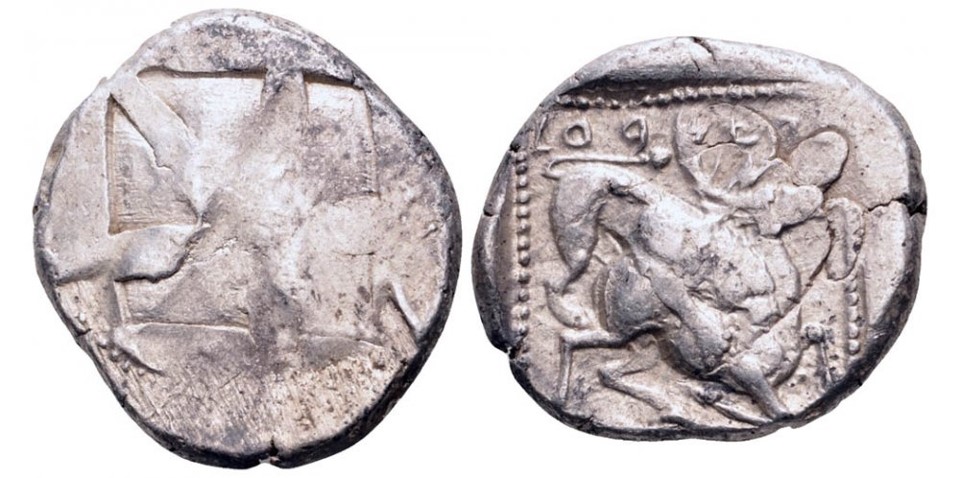449 BCE - 425 BCE | L'Z'B'L (in Aramaic)
Overstriking coin
Citium_over_Aegina_Roma_Numismatics,_25_May_2017,_171.jpg
[1]
|
|
Sale(s)Sale(s) ᵖ:
|
Roma Numismatics, EA 36, 27 May 2017, 171
|
|
|
|
Description
| ObverseInscription or printing placed on the obverse.:
|
Herakles in fighting stance to right, wearing lion skin upon his back and tied around neck, holding club overhead in right hand and bow extended before him in left hand.
|
ReverseInscription or printing placed on the reverse.:
|
L'Z'B'L (in Aramaic) (Aramaic) Lion attacking stag crouching right inside dotted border within incuse square.
|
Mint and issuing power
Chronology
| FromIdentifies the initial date in a range assigned in a numismatic context. 449 BCE toIdentifies the final date in a range assigned in a numismatic context.. 425 BCE
|
Classical 480-323 BC  periodTime period of the numismatic object. periodTime period of the numismatic object.
|
Physical description
MetalThe physical material (usually metal) from which an object is made.: Silver 
|
WeightWeight of the numismatic object (in grams). in grams: 11.0611.06 g <br />11,060 mg <br />
|
DenominationTerm indicating the value of a numismatic object. Examples: tetradrachm, chalkous, denarius.: double siglos 
|
|
| DiameterDescribes diameter of an object (in mm).: 2323 mm <br />2.3 cm <br />
|
StandardStandard.: Persian
|
References
Description
| ObverseInscription or printing placed on the obverse.:
|
Sea turtle (visible on the coin's reverse : into the top right hand corner).
|
ReverseInscription or printing placed on the reverse.:
|
Incuse square (visible on the coin's obverse : mill-sail reverse pattern).
|
Mint and issuing power
| MintIdentifies the place of manufacture or issue of a numismatic object. ᵖ:
|
Aegina
|
Ancient regionAncient region. ᵖ
|
Attica
|
Modern countryModern country: Greece
|
AuthorityIdentifies the authority in whose name (explicitly or implicitly) a numismatic object was issued. ᵖ:
|
|
Chronology
| FromIdentifies the initial date in a range assigned in a numismatic context. 480 BCE toIdentifies the final date in a range assigned in a numismatic context.. 457 BCE
|
Classical 480-323 BC  periodTime period of the numismatic object. periodTime period of the numismatic object.
|
Physical description
| DenominationTerm indicating the value of a numismatic object. Examples: tetradrachm, chalkous, denarius. ᵖ:
|
stater 
|
StandardStandard. ᵖ:
|
Aeginetic
|
References
| Frequency of overstrikesFrequency of overstrikes:
|
frequent
|
Level of confidenceLevel of confidence of the identification:
|
sure
|
| RemarksRemarks:
|
"Obverse weakly struck leaving most of the undertype visible, this being an Aegina stater mill-sail reverse pattern, while the sea turtle from the obverse of the Aegina stater is still partially visible swimming into the top right hand corner of the incuse square of the Kition over-type"
|
References
- ^ Tziambazis, Elias (2002), A catalogue of the coins of Cyprus: from 560 B.C. to 1571 A.D., Larnaca, 89 p.
- ^ Zapiti, Eleni - Michaelidou, Lefki (2008), Coins of Cyprus : from the collection of the Bank of Cyprus Cultural Foundation, Nicosia, Bank of Cyprus Cultural Foundation, 329 p.
- ^ Hoover, Oliver D. (2010), The Handbook of Greek Coinage Series, volume 6 : handbook of coins of the islands: Adriatic, Iionian, Thracian, Aegean, and Carpathian seas (excluding Crete and Cyprus), sixth to first centuries BC, Lancaster, 358 p.
- ^ Meadows, Andrew (forthcoming), Greek coinage in the Persian Empire: The Malayer 1934 Hoard (IGCH 1790).

